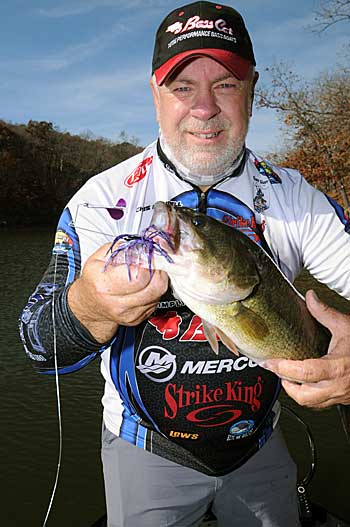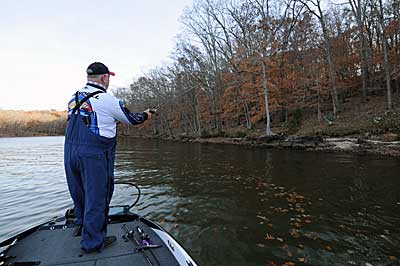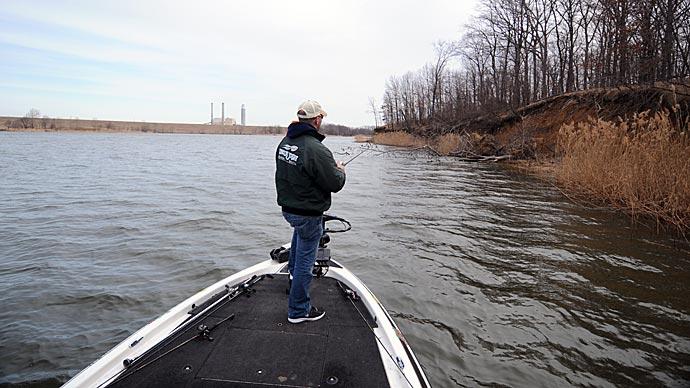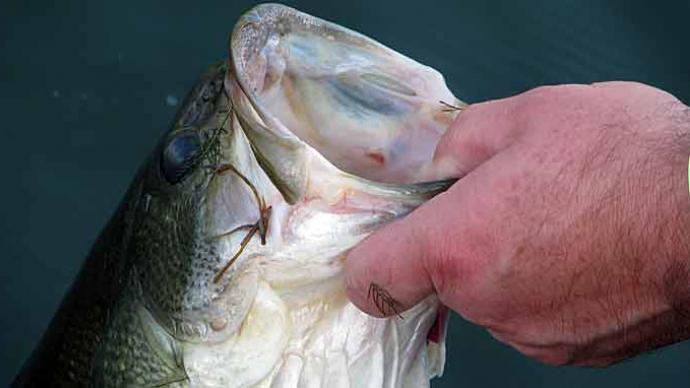
The Snow Bowl reinforced Chris Randell’s belief in throwing a buzz bait in cold conditions.
The Snow Bowl was the moniker given to the November 1997 Bassmaster Missouri Invitational at Lake of the Ozarks when the first winter storm of the season arrived at the lake. Tournament competitors faced cold, cloudy, and wet conditions most of the week, with a heavy snowfall dumping 1 to 2 inches of accumulation on the first competition day. Morning temperatures throughout the competition days dipped into the 20-degree range, and the daytime temperatures hovered around the 32-degree mark with a 15- to 20-mph northwest wind creating a wind chill of 5 degrees the first competition morning. The average water temperature throughout most of the lake was in the 50-degree range.
During the practice days of the tournament, Randell caught bass mainly on a spinnerbait, which he planned on using primarily on the competition days. However, a buzz bait also produced some fish for him in practice, so when his first-day partner Ken Cook controlled the boat and kept catching quality bass on a spinnerbait, Randell knew he needed to try something different. Despite the frigid conditions, Randell switched to a white 1/2-ounce Strike King Pro Buzz buzz bait with a red blade and caught four bass in moving into eighth place in the tournament's opening round. Despite the dropping water temperatures, Randell stuck with buzz bait the next two days and caught four quality bass each day. His three-day total of 12 bass weighing 37 pounds, 6 ounces led to a fifth-place finish out of a field of more than 300 competitors.
Since that tournament, the buzz bait has become a critical lure in Randell’s arsenal when the leaves start accumulating on the water in the fall. The Missouri angler has changed his buzz bait selection from the Strike King buzzer to his custom-designed Giant Slayer buzz bait that he crafts in 3/8- and 1/2-ounce models. Randell equips the Giant Slayer buzz bait with a heavy wire, long Mustad hook, which provides a gap of about 2 1/4 to 2 1/2 inches between the back of the blade and the point of the hook. He believes the wider opening provides better hookups than buzz baits with shorter shanked hooks and allows him to fish the buzzer without a trailer hook.
Randell’s blade and skirt color choices depend on the weather. “On a sunny day, I like dark colors, but I also like the old spinnerbait theory of gold and silver blades giving off a little flash,” he says. “I like that dark skirt on a high sky day, and I will throw lighter colors on a low light day. A glimmer blue skirt is good if the fish are gorging on gizzard shad. I also like red blades and white blades.” The tournament competitor has been catching bass lately on a buzzer with a purple blade and purple skirt. A color combination Randell selects when he wants to show bass a different look.
While some anglers stop fishing a buzz bait when the water temperature drops below 60 degrees in the fall, Randell considers 58 degrees an optimal temperature for presenting a buzz bait to Northern strain bass. “I have a rule of thumb that I will keep trying it as the day goes on because I am a power fisherman,” Randell says. “It is a very aggressive bait, and you can cover more water with a buzz bait than anything else.
“Water temperature is the key to slowing down the bait,” Randell says. “When the water is in the 50’s, the fish may be a little bit lethargic and want a slower retrieve, but as the day goes on and the fish start getting warmed up, they will get a little more aggressive.”

Randell employs a steady retrieve on a 6 1/2-foot medium-heavy action rod and a Lew’s Tournament Pro 8.3:1 gear ratio baitcast reel filled with 20-pound Berkley Big Game monofilament line. He prefers monofilament because it stretches better than braid, which prevents him from ripping the hook out of the fish on the hook set.” Randell claims a steady retrieve helps bass hone in on the buzz bait better. “If you put a twitch in the retrieve, the fish may either think not to hit it, or the fish will miss it,” he says.
After a strike on his buzz bait, Randell hesitates on setting the hook until he feels the weight of the bass on his line. “You have to hesitate on the hook set, so on my retrieve, I have my rod tip at about a 9:30 position so I can drop the rod and lay into the fish,” he says.
Short strikes are a common dilemma when throwing a buzz bait, so Randell has some follow-up baits on his boat deck. His first follow-up cast will be with the buzz bait, but if that fails to draw a strike, Randell will throw a spinnerbait next. He follows the spinnerbait by pitching a black-and-blue Strike King Flipping Tube to any piece of cover nearby that the fish might use as an ambush point.
Cloudy skies and an approaching storm after two or three days of stable fall weather are prime conditions for Randell’s buzz bait tactics. “When a storm is coming in, and you can feel that barometric pressure getting real low, it is ideal for buzz baits,” Randell says. “When the pressure gets low, bass come up shallow. It makes the fish very aggressive, so I turn to being very aggressive with my buzz bait and get more bites that way.”
When conditions are right, Randell seeks specific targets for buzzing. “In the cooler weather, I like to get on chunky rock banks,” he says. “Bass will still relate to main lake points, secondary points, and little points in the backs of pockets.” Rock riprap is another good buzz bait target because it absorbs heat and draws in bass throughout the day
Randell also targets shallow wood cover such as laydowns and brush piles or larger rocks he sees along a bank. The tournament veteran will make multiple presentations with his buzz bait to these targets to draw strikes. If he fails to catch any bass on a spot where he has caught fish in the past, he will return to it later and tempt the fish with his buzz bait again.
BassResource may receive a portion of revenues if you make a purchase using a link above.




